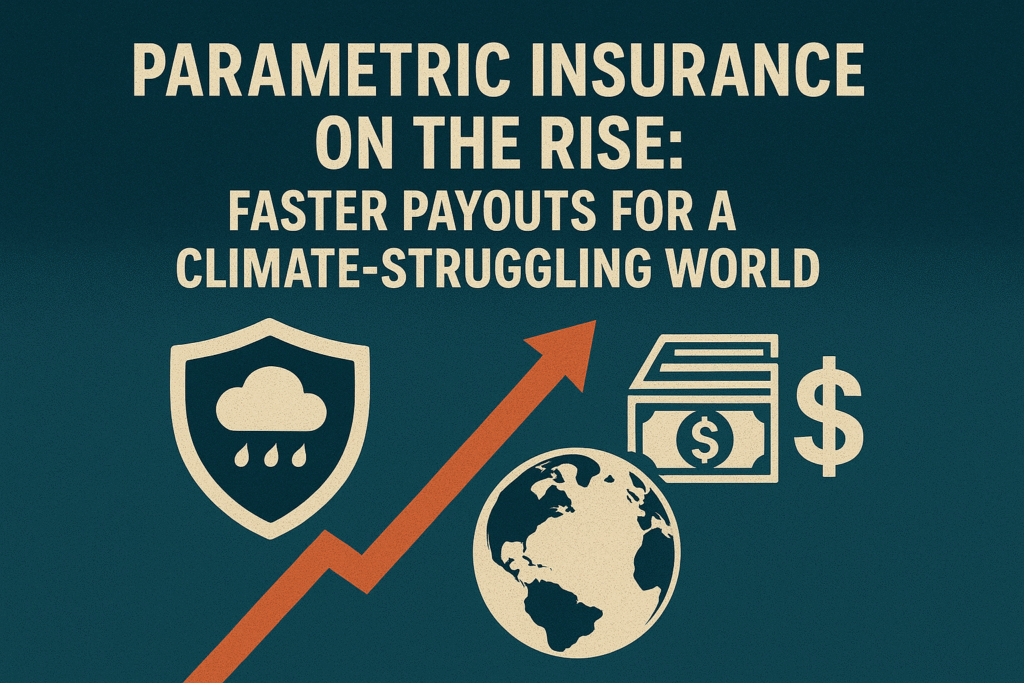Parametric insurance is revolutionizing disaster recovery. Discover how this data-driven model uses triggers for instant payouts, helping businesses and governments build resilience in an era of climate chaos.
The Broken Promise of Protection
In the immediate aftermath of a hurricane, flood, or drought, time is the one commodity that victims don’t have. Traditional insurance, the very industry designed to be a financial lifeline in these moments, often becomes a source of further frustration. The process is notoriously slow: waiting for an adjuster to access the disaster zone, debating the extent of the damage, and haggling over the final settlement. For a business or a farmer, this delay can be the difference between recovery and ruin.
This gap between the promise of protection and the reality of a protracted claims process has never been more dangerous. As climate change fuels more frequent and severe weather events, the traditional indemnity-based insurance model is cracking under the pressure. It is too slow, too adversarial, and too expensive to administer at the scale now required.
Emerging from this crisis is a revolutionary alternative: parametric insurance. Also known as index-based insurance, it represents a fundamental paradigm shift from paying for assessed loss to paying for measured events. It is not just a new product; it is a new philosophy of risk transfer, built for speed, transparency, and the urgent demands of a climate-struggling world. This article delves into the mechanics, applications, and profound implications of this rapidly rising model, explaining how it is turning the promise of instant financial aid from a dream into a contractual certainty.
The Mechanics of a Revolution – How Parametric Insurance Works
To understand its power, one must first grasp its elegant simplicity. Parametric insurance severs the direct link between a policy payout and a traditional, on-the-ground damage assessment.
The Core Principle: Triggers, Not Losses
A parametric policy is structured around a predefined trigger event and an objective, third-party parameter or index.
- The Parameter (The “What”): This is a specific, verifiable metric that strongly correlates with the type of loss the policy is meant to cover. Common parameters include:
- Wind Speed: Measured at a specific, official weather station.
- Earthquake Magnitude: As recorded by a designated seismic institute (e.g., USGS).
- Rainfall Amount: Measured in millimetres over a set period by a recognised meteorological agency.
- Temperature or Frost Levels: Critical for agriculture.
- Hurricane Category/Saffir-Simpson Scale: Based on National Hurricane Center data.
- Water Level (Storm Surge): Measured by a specific tidal gauge.
- The Trigger (The “When”): The policy explicitly defines the threshold that the parameter must exceed to activate a payout. For example:
- “Wind speeds ≥ 100 km/h at London Gatwick Airport weather station.”
- “Rainfall ≤ 20mm during the defined growing season at the official Met Office gauge in Essex.”
- “An earthquake of magnitude 6.0 or higher with an epicentre within 50 km of policy coordinates.”
- The Payout (The “How Much”): The contract specifies a fixed payout amount that is automatically paid once the trigger is verified. This payout can be:
- Binary: A full, pre-agreed sum is paid if the trigger is met. (e.g., £1 million if the hurricane is Category 3+).
- Scaled: The payout increases in increments as the parameter intensifies. (e.g., £100,000 for every 10 km/h over 100 km/h wind speed).
The “Basis Risk” Trade-Off:
The main criticism of parametric insurance is basis risk—the possibility that the trigger event occurs but the policyholder experiences little to no loss, or conversely, that a loss occurs without the trigger being met. A business might suffer flood damage from a localised event not captured by the official weather station, for example. Mitigating basis risk is the art of parametric design, requiring careful selection of parameters and triggers that most accurately reflect the client’s actual exposure.
Why Now? The Perfect Storm Fueling Parametric’s Rise
The concept isn’t new (it has roots in agricultural insurance), but its adoption is exploding due to a convergence of critical factors.
1. The Accelerating Climate Crisis:
The frequency and severity of natural catastrophes are overwhelming traditional insurers. The lengthy, resource-intensive process of sending adjusters into every disaster zone is becoming logistically impossible and economically unviable. Parametric insurance offers a scalable solution.
2. The Data Revolution:
The model is entirely dependent on high-quality, reliable, and instantaneous data. We now live in a world saturated with it. From government weather satellites and seismic networks to private IoT sensors and drone imagery, the data infrastructure to power parametric contracts is more robust and accessible than ever before.
3. The Demand for Speed and Certainty:
Businesses, governments, and NGOs have seen the devastating impact of cash flow interruption after a disaster. They are no longer willing to accept months of uncertainty. They need capital immediately to begin recovery, pay employees, and secure their operations. The promise of a payout within days, not months, is a compelling value proposition.
4. The Protection Gap in Emerging Economies:
Large swathes of the developing world are severely underinsured. Traditional insurance is often unaffordable or unavailable. Parametric insurance, often backed by international development banks and reinsurers, offers a way to provide financial resilience to entire countries and vulnerable agricultural communities at a lower administrative cost.
5. Market Fatigue with Traditional Claims:
The adversarial nature of traditional claims—where the insurer and client debate the value of a loss—damages relationships. Parametric contracts remove this friction. The outcome is based on objective data, making the process transparent and conflict-free.
Real-World Applications – Who is Using Parametric Insurance Today?
The use cases for this model are vast and growing exponentially beyond its agricultural origins.
1. Sovereign Disaster Risk Financing:
Caribbean and Southeast Asian nations, perennially battered by hurricanes and typhoons, are leading adopters. Countries like Jamaica and the Philippines have taken out parametric sovereign policies. When a predefined storm hits, the government receives an immediate infusion of cash to fund emergency response and critical infrastructure repairs without waiting for international aid or draining national reserves.
2. Corporate Business Interruption:
- A Tourism Resort in Florida: Buys a parametric policy triggered by a hurricane forcing the closure of the local airport for 48+ hours. The payout covers fixed costs and lost profits during the closure.
- A Manufacturing Plant: Insures against a specific temperature drop that would freeze and damage pipelines, with a trigger based on data from a nearby weather station.
- Event Cancellation: A music festival organiser insures against rainfall exceeding a certain amount on the event days, providing a payout to cover lost revenue.
3. Agriculture (The Original Use Case):
- Drought Protection: A farmer’s payout is triggered if rainfall at the county gauge is below a certain level during the crucial growing season.
- Excess Heat/Frost: Winemakers use parametric triggers for temperature extremes that can destroy a vintage.
4. Renewable Energy:
- Wind Farms: Insure against low wind speeds that cause energy production to fall below a guaranteed threshold.
- Solar Farms: Insure against excessive cloud cover or hail damage based on meteorological data.
5. Supply Chain and Logistics:
A company with a critical supplier in a earthquake-prone region can take out a parametric policy tied to seismic activity in that area. If a quake hits, the payout provides immediate capital to find an alternative supplier and minimise production delays.
The Advantages – Why Parametric is a Game-Changer
The benefits of this model are transformative for all parties involved.
For the Policyholder:
- Speed: Payouts are made in days, sometimes hours, after the triggering event is verified.
- Certainty: The rules of the game are clear from the start. There is no negotiation over the loss amount.
- No Claims Process: The need for invasive loss adjusters and lengthy paperwork is eliminated.
- Flexibility: The payout is cash. The recipient can use it for any purpose—covering lost revenue, payroll, emergency repairs, or even public relations efforts to reassure customers.
- Transparency: The trigger is based on objective, third-party data that all parties can monitor.
For the Insurer:
- Lower Administrative Costs: No need for a large global network of loss adjusters to assess each claim individually.
- Scalability: Can insure large portfolios of risks efficiently using the same data triggers.
- Reduced Disputes: Eliminates arguments over the value of a claim, preserving client relationships.
- Capital Efficiency: Allows for the securitization of risk through instruments like catastrophe bonds (cat bonds), transferring peak risk to the capital markets.
The Challenges and Limitations – Not a Panacea
For all its promise, parametric insurance is not a perfect replacement for traditional coverage.
- Basis Risk: As discussed, this is the fundamental challenge. A perfect correlation between index and loss is difficult to achieve.
- Complex Structuring: Designing a effective parametric product requires deep expertise in data science, modelling, and the specific risk being covered. It is not an off-the-shelf product.
- Basis Risk: As discussed, this is the fundamental challenge. A perfect correlation between index and loss is difficult to achieve.
- Perceived Complexity: For buyers unfamiliar with the model, it can seem abstract and confusing compared to traditional “we’ll repair your building” coverage.
- Moral Hazard (or Lack Thereof): Since the payout is not tied to actual loss, there is no financial incentive for the policyholder to mitigate damage after the event. However, there is also no incentive to exaggerate a claim.
The Future – A Hybrid World
The future of insurance is not a choice between parametric and traditional models; it is a hybrid one.
- Parametric as a Catalyst: We will see more policies where a parametric trigger provides an immediate, upfront cash injection to stabilise the situation, followed by a traditional claims process for the detailed, longer-term recovery and rebuilding costs.
- IoT Integration: The rise of the Internet of Things (IoT) will drastically reduce basis risk. Instead of relying on a weather station 10 miles away, a policy could be triggered by data from a soil moisture sensor in a farmer’s field or a water-level sensor on a specific building.
- Blockchain for Trust and Automation: Smart contracts on a blockchain could automate the entire parametric process: the oracle (data feed) verifies the trigger event, and the smart contract automatically executes the payout instantly and irrevocably, removing any administrative delay.
Conclusion: The New Architecture of Resilience
Parametric insurance is more than a financial product; it is a fundamental re-engineering of resilience for the 21st century. It acknowledges that in a world of increasing climate volatility, the greatest value an insurance policy can provide is not just capital, but speed.
By leveraging objective data to automate trust and trigger immediate action, it offers a beacon of certainty in an increasingly uncertain world. It empowers governments to respond faster to crises, enables businesses to survive disruptions that would have once doomed them, and provides a lifeline to the most vulnerable communities on the front lines of climate change.
While it won’t replace traditional insurance for all risks, its rise signals a necessary and welcome evolution. In the face of mounting climate threats, the industry is finally innovating to keep its most important promise: to be there when it is needed most. Parametric insurance ensures that “when” is now measured in days, not months.


